Aztec were an Indigenous (native) people who ruled a mighty empire in Mexico during the 1400’s and early 1500’s. The Aztec had one of the most advanced civilizations in the Americas. They built cities as large and complex as any in Europe at that time. They also practiced a remarkable religion that affected every part of their lives. To worship their gods, the Aztec developed a sophisticated ritual system, built towering temples, and created huge sculptures. They held impressive religious ceremonies featuring dancing, musical performances, and the bloody sacrifices of animals and human beings.
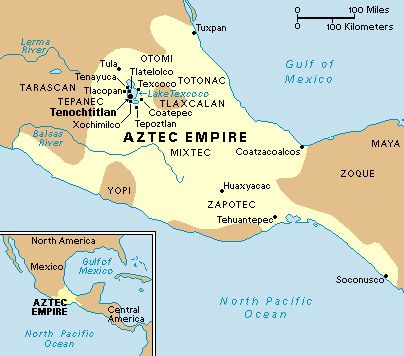
The name Aztec is also commonly applied to the people who founded Tenochtitlan << tay nohch TEE tlahn >>. This city stood on the site of present-day Mexico City and, according to legend, was established in 1325. Its people referred to themselves by the names Colhua-Mexica, Mexica, and Tenochca. In the 1400’s, the city and its allies conquered many groups in central and southern Mexico, forming the Aztec Empire. Tenochtitlan became the capital. The empire was destroyed by the Spaniards, who conquered Tenochtitlan in 1521. But the Aztec left a lasting mark on Mexican culture. Aztec also refers to the larger group of Indigenous people who made up the empire. This article uses Aztec in that sense.
The Aztec Empire
The center of Aztec civilization was the Valley of Mexico, a huge, oval basin about 7,500 feet (2,300 meters) above sea level. Although the valley was in the tropics, its high altitude gave it a mild climate. The surrounding lowlands had a hotter, wetter climate.
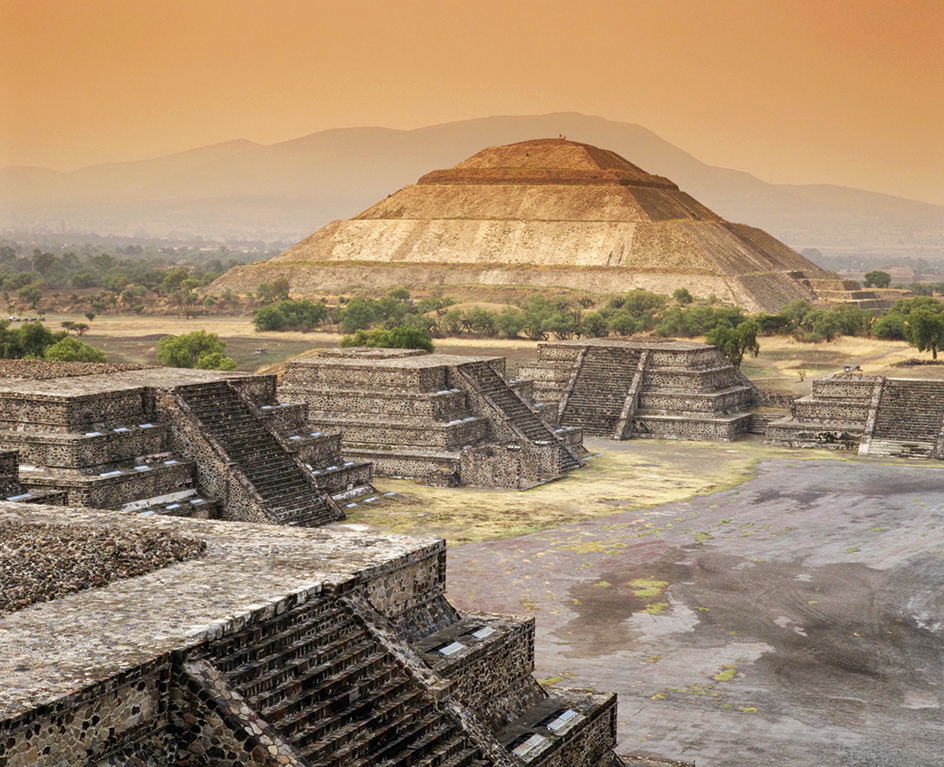
The Aztec Empire included as many as 20 million people in about 400 cities and towns. Most were concentrated in the Valley of Mexico, but the empire extended well beyond that. The largest city was the capital, Tenochtitlan, which occupied an island in Lake Texcoco. Causeways (raised earthen roads) linked the city to the mainland. On a nearby island to the north stood the city of Tlatelolco, a commercial center. Both Tenochtitlan and Tlatelolco lay within the borders of what is now Mexico City. Present-day Mexico City covers much of the bed of Lake Texcoco, which was drained during the 1600’s. In 1473, warriors of Tenochtitlan conquered Tlatelolco and united the two cities. When the Spaniards arrived in the 1500’s, Tenochtitlan may have had a population of about 200,000 people. The Spaniards were astonished by its complexity and richness when they first saw it. No Spanish city had so many people. They compared it to Constantinople (now Istanbul, Turkey), the capital of the Ottoman Empire, and other great European cities.
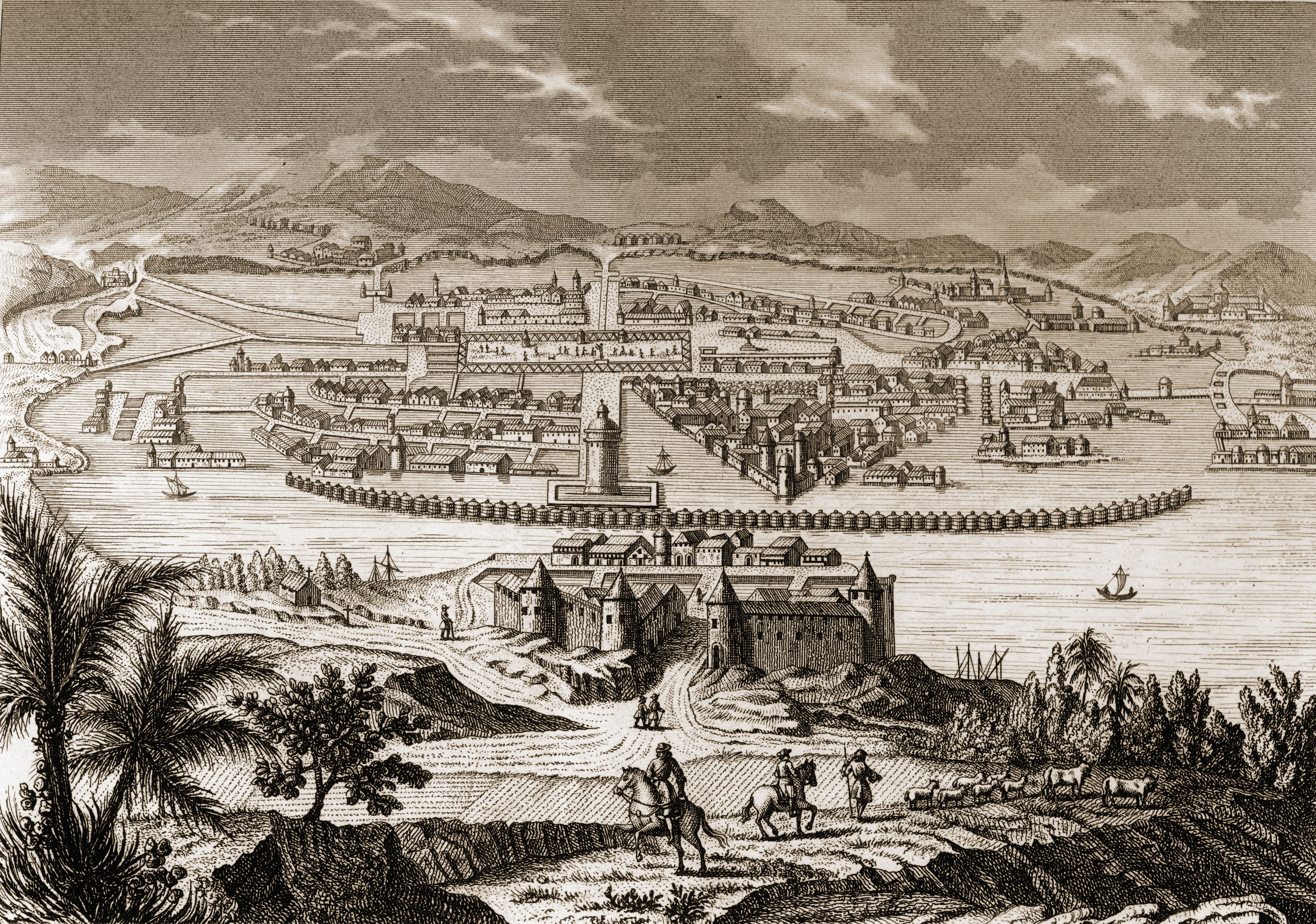
The emperor of the Aztec was called the huey tlatoani (great speaker). A council of high-ranking nobles chose him from the members of the royal family. The emperor, who was considered to have both human and supernatural abilities, had immense political power. However, he had to consult the council of nobles when making important decisions. Military units were stationed in key locations throughout the empire to keep it secure. Most of these units were commanded by a great noble, who often also served as governor of the territory. An elaborate system of government offices administered the affairs of the empire. Many of the top positions were hereditary, but service to the emperor was another way for a person to obtain high office.
Aztec society had four main classes: (1) nobles, (2) commoners, (3) serfs, and (4) enslaved people. Among nobles and commoners, closely related families belonged to groups called calpollis. The members of a calpolli owned an area of land in common, and each family was allowed to farm a plot large enough for its needs. In addition to their calpolli land, most nobles had their own private land or received government land for use during their term in public office. Commoners made up the majority of the population, and many made a living by farming their calpolli plots. Serfs worked the land held by nobles and remained on the land when a new noble acquired it. Enslaved people were considered property, but their children were born free. Many enslaved people had been captured in war. The Aztec also purchased enslaved people from other groups. Other enslaved people were criminals or people who could not pay their debts.
Way of life
Religion
was extremely important in Aztec life. The people devoted much of their time to religious practices, such as praying, singing, dancing, pilgrimages, and offerings. They even waged war largely to obtain prisoners to sacrifice to their gods.
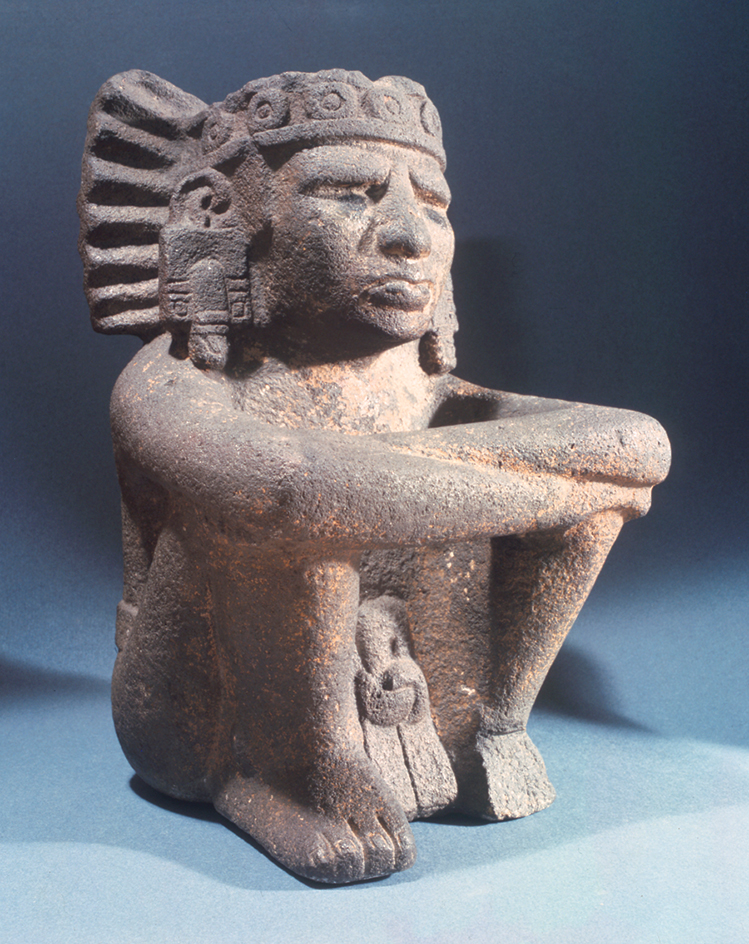
The Aztec worshiped many gods and goddesses, each of whom ruled one or more human activities or aspects of nature. The Aztec economy was based largely on farming, and so the people had many agricultural divinities. They included Centeotl, a corn god; Tlaloc, a rain and fertility god; and Xipe Totec, associated with springtime and regrowth. Other major gods included Tezcatlipoca, an all-powerful divinity; Tonatiuh, the sun god; Mictlantecuhtli, ruler of the dead; and Xiuhtecuhtli, the fire god. Huitzilopochtli, a war god, was the special guardian of the people of Tenochtitlan. Xochiquetzal was a goddess of fertility, weaving and other women’s crafts, flowers, and beauty. The god Quetzalcoatl was associated with civilization and learning. However, he sometimes took the form of Ehecatl, god of the wind.
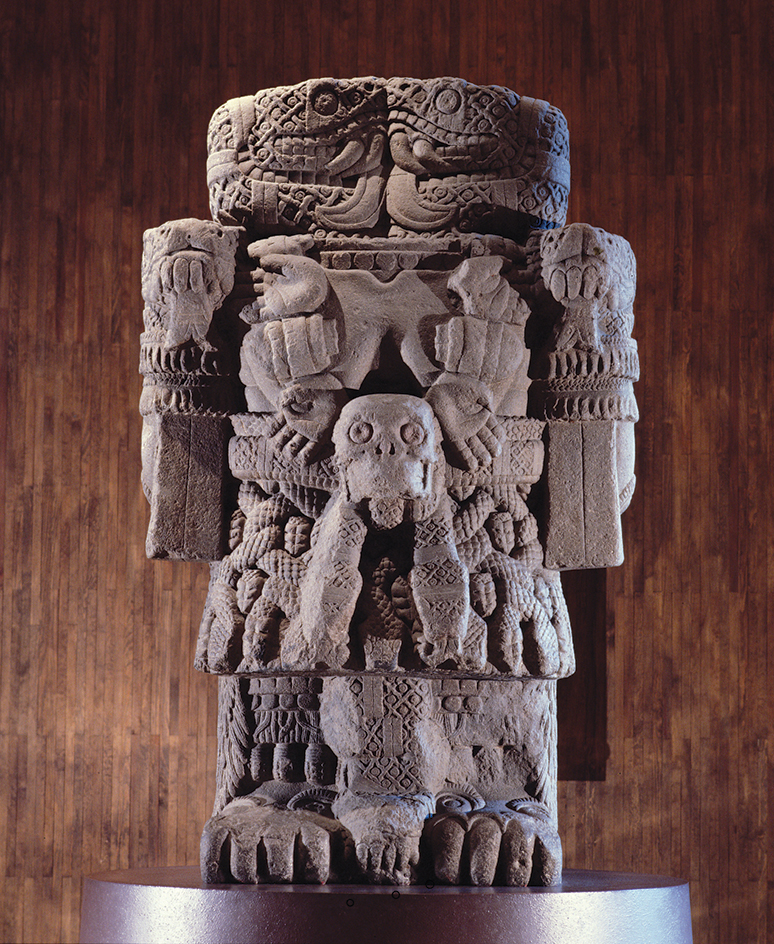
The Aztec held many religious ceremonies. The most important observed planting, harvesting, and other events in the agricultural year. The purpose of many ceremonies was to motivate people to work together to ensure good crops by winning the favor of the gods.
Human and animal sacrifice played a vital role in the ceremonies. The Aztec regarded the human body and all living things as gifts from the gods. They believed that a divine power resided in three parts of the body—the head, the heart, and the liver. The Aztec thought that the gods required a ritual payment in the form of human hearts and blood to remain strong. Human sacrifices were elaborate, dramatic ceremonies designed to magically transform the human victims into living representatives of the gods before they were sacrificed. Often, priests slashed open the chest of a living victim and tore out the heart. Worshippers sometimes ate portions of a victim’s body. They may have thought that the dead person’s strength and bravery passed to anyone who ate a portion of the flesh. Most victims were prisoners of war or enslaved people. The Aztec also sacrificed women and occasionally, to the god Tlaloc, children.

Most religious activities took place inside walled ceremonial centers. The chief structures within the centers were teocallis. A typical teocalli consisted of a wide solid base upon which rose steep stairsteps. Priests climbed the stairs to reach the temple dedicated to a divinity at the top. The ceremonial centers also included royal palaces, gardens, living quarters for priests, sacred pools for ritual cleansing, and racks holding the skulls of sacrificial victims. In addition, many centers had a tlatchli (playing court) for a game called ullamaliztli that resembled a mixture of soccer and basketball. The players tried to hit a rubber ball through a ring with their hips and knees. They could not use their hands or feet.
The Aztec had a 260-day religious calendar. Priests used the calendar to determine lucky days for such activities as sowing crops, building houses, and going to war. The Aztec also had a 365-day solar calendar. It consisted of 18 months of 20 days each plus 5 extra days.
Every 52 years, the Aztec held a great celebration called the Binding of the Years or the New Fire Ceremony. Before the celebration, people throughout the empire let their hearth fires go out and destroyed some of their kitchenware. At the start of the new 52-year cycle, the priests lit a fire on the chest of a sacrificial victim. People pricked themselves to add their blood to the sacrifice. Fire bearers delivered the sacrificial fire to towns and cities throughout the empire. Then the people relit their hearth fires from the new fire and feasted.
Family life.
The typical Aztec household consisted of a husband and wife, their unmarried children, and a number of the husband’s relatives. All members of this extended family, including the children, helped with the work. The husband’s chief responsibility was to support the family, usually by farming or craftwork. The wife’s duties included weaving the family’s clothing, raising girls in the home, and cooking the family’s food.
Boys were educated by their father until about the age of 10. They then attended a school run by their calpolli or—especially if they belonged to the nobility—a school connected with a temple. Calpolli schools provided general education and military training. Temple schools offered a religious education, which prepared boys to become priests or other leaders. Some girls also attended the temple schools, but the majority learned household skills at home. The Aztec married at an early age, women at about 16 and men at about 20.
Food.
Many types of corn and squash were staples of the Aztec diet. The principal food was a thin corn flat bread called a tlaxcalli. In Spanish, it is called a tortilla. The Aztec used tlaxcallis to scoop up other foods or wrapped them around bits of meat and vegetables to form tacos. Aztec cooking was rich and spicy. Many dishes had sauces flavored with chili peppers.
Hunting and, to a lesser extent, fishing provided animal protein for the Aztec diet. Game animals included deer, rabbits, and such birds as ducks and geese. The only animals raised for meat were dogs and turkeys.
The Aztec used the juice of maguey plants to make an alcoholic beverage called octli. Chocolate drink was also a favorite beverage, but only the wealthy could afford to have it often.
Clothing.
Aztec women wore a loose, sleeveless blouse and a wraparound skirt. Men wore a cloth around their hips and a cloak knotted over one shoulder. The poorer people used cloth made from maguey fibers, but richer people had cotton clothing. The amount of decoration on a garment further indicated the wealth and social rank of the wearer. When the Spaniards first arrived in Tenochtitlan, they were amazed by the elaborate and rich clothing of the Aztec nobles.
Shelter.
Most houses for Aztec commoners were simple and designed for usefulness rather than beauty. In the highlands, the houses were made of adobe. In the lowlands, they had thatched roofs, and the walls were made of branches or reeds plastered with clay. In addition to the main dwelling, most families had several other buildings, including a storehouse and a small sweat house, where the family took steam baths. Wealthy Aztec families had large adobe or stone houses finely decorated and built around a patio.
Arts and crafts.
Aztec sculptures, which decorated temples and other buildings, were among the most elaborate in the Americas. The most famous surviving Aztec sculpture is the large, circular Sun Stone, which represents the Aztec universe. The stone measures about 12 feet (3.7 meters) in diameter. In its center is the face of the sun god Tonatiuh. Other carvings represent the days of the Aztec month and religious symbols related to the sun god. Many archaeologists believe that Aztec priests placed the hearts of human sacrifices on the stone.
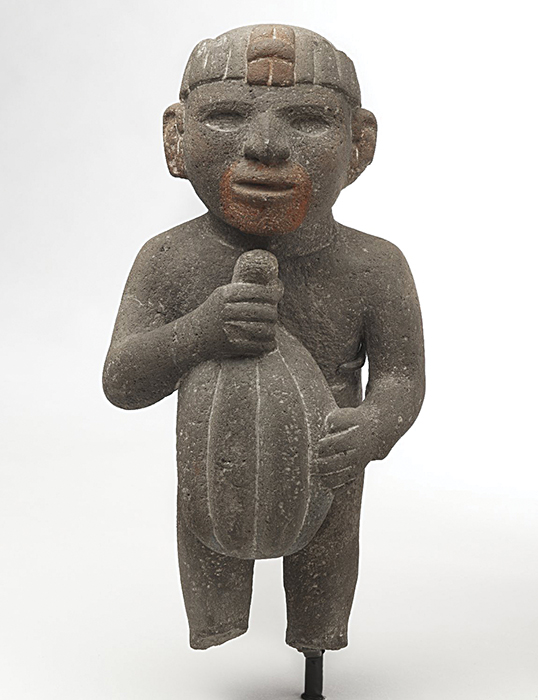
The Aztec produced various forms of oral literature, including poetry and traditional accounts of their history. When Spanish priests studied this oral tradition, they were deeply impressed by the elaborate metaphors and prose used by the Aztec speakers.
Music played a major part in religious services. The chief instruments were drums, flutes, and rattles.
Aztec craftworkers used feathers to make cloaks, headdresses, and other garments. Other crafts included metalworking, pottery, weaving, and woodcarving.
Language.
The Aztec spoke a language called Nahuatl. It belongs to a large group of Indigenous languages known as the Aztec-Tanoan or Uto-Aztecan family. This language family also includes the languages spoken by the Comanche, Pima, Shoshone, and other tribes of western North America.
The Aztec used a form of writing called pictographic writing, which consisted mostly of images, pictures, and scenes. Some pictures symbolized ideas. Others stood for the sounds of syllables. For example, the Aztec town of Coatepec was represented by a snake and a hill. The Nahuatl words for snake and hill were coatl and tepetl, which together sounded like Coatepec. This system of writing was not developed enough to provide full expression of ideas, and so the Aztec combined pictorial images with oral explanation or interpretation. They used the pictorial system alone for business records, censuses, and tax lists.
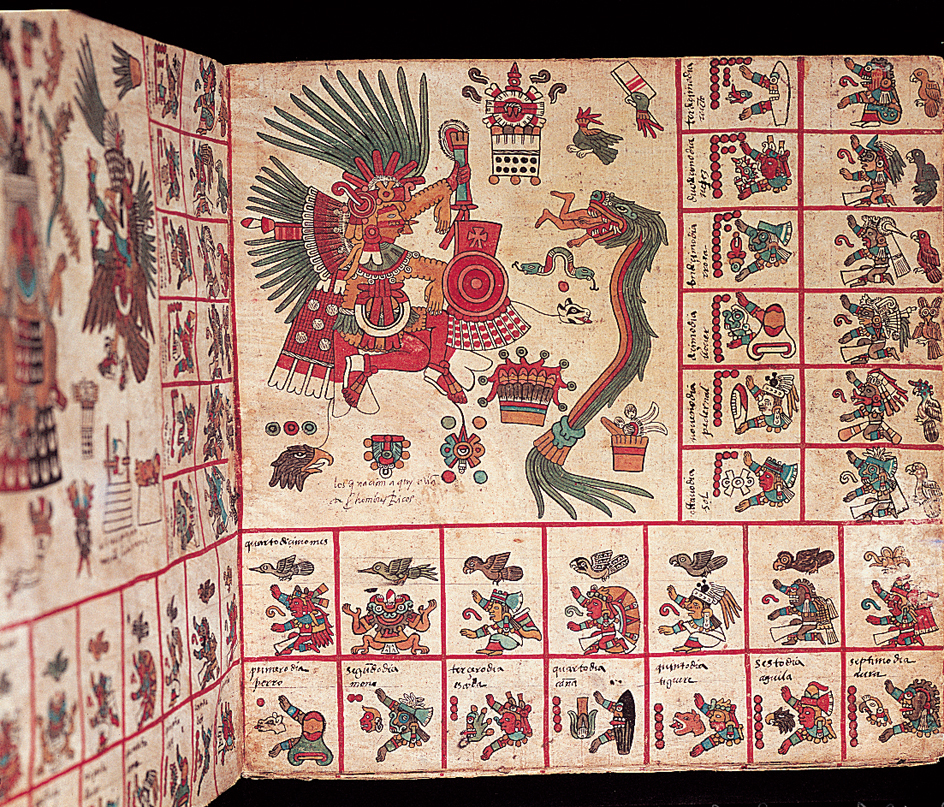
Warfare
was considered a religious duty by the Aztec. They fought not only to enlarge their empire but also to take prisoners to sacrifice to the gods. The highest goal for a young man was to be a successful warrior. Men who took many captives in battle were rewarded with land, high social rank, and important government offices. Warriors wore costumes that symbolized their accomplishments and rank.
Aztec methods of combat were designed primarily to capture prisoners rather than to kill. The chief weapon was a wooden club edged with sharp pieces of the volcanic glass obsidian. This weapon, called a macuahuitl, was effective for disabling an opponent without killing him. The Aztec also used bows and arrows and spears. A spear-throwing device called an atlatl increased the range and force of their spears. For protection, warriors carried shields and wore armor of tightly quilted cotton.
Economy
Agriculture
formed the basis of the Aztec economy. Corn was the most important crop. Farmers also grew avocados, beans, squashes, sweet potatoes, tomatoes, and many other crops. The lowlands provided such tropical products as cotton, papayas, rubber, and cacao beans, from which chocolate is made.
The basic agricultural tool was a pointed stick for digging. In the densely forested lowlands, farmers practiced slash-and-burn agriculture. They chopped down and burned a section of forest, then planted crops in the clearing. The ashes fertilized the soil. In the highlands, the Aztec cut terraces into the hillsides to increase the amount of level farmland. They also dug irrigation systems to water their crops. In addition, farmers turned areas of shallow lakes into cropland by scooping up mud from the lake bottoms to form islands. These islands were called chinampas. The farmers regularly added fresh mud, which was extremely fertile. As a result, the chinampas yielded huge crops. Lake Xochimilco in Mexico City still has many chinampas. Although they do not float, they are often called floating gardens.
Trade and transportation.
The marketplace was a major center of Aztec life. The market at Tlatelolco was the largest in the Americas. It displayed nearly every kind of merchandise available in the Aztec world. The Spanish explorer Hernán Cortés reported that more than 60,000 people visited it daily. There were also many smaller markets throughout the empire. Government officials supervised the trading.
Merchants called pochteca traveled throughout the empire on trading expeditions and also served as spies. The merchants employed many bearers, who marched in long caravans with heavy loads on their backs. People of the lowlands traded such products as cacao beans, cotton, jaguar pelts, rubber, and the feathers of tropical birds. In return, they received goods from the highlands. These goods included obsidian—which was used for knives and weapons—and a variety of manufactured products.
The Aztec had no system of money as we know it. They usually traded goods and services for other goods and services. But the Aztec used cacao beans and other widely acceptable goods somewhat as we use money.
The Aztec used the wheel only in toys, and they had no beasts of burden. As a result, the people themselves carried all their goods on land. Dugout canoes were an important means of transportation in the Valley of Mexico, which had many lakes, canals, and other waterways.
History
The Aztec migration.
According to legend, the ancestors of the Aztec came to the Valley of Mexico from a place in the north called Aztlan or Chicomoztoc (Place of Seven Caves). Their supreme deity inspired them to leave their homeland and travel until they found a new home, which would be marked by an eagle eating a serpent on a blooming cactus. The name Aztec comes from Aztlan. The Aztec wandered for many years before settling in the valley in the 1200’s. At first, they were subjects of people who lived in the area. But in 1325, the legend says, they founded their own city, Tenochtitlan.
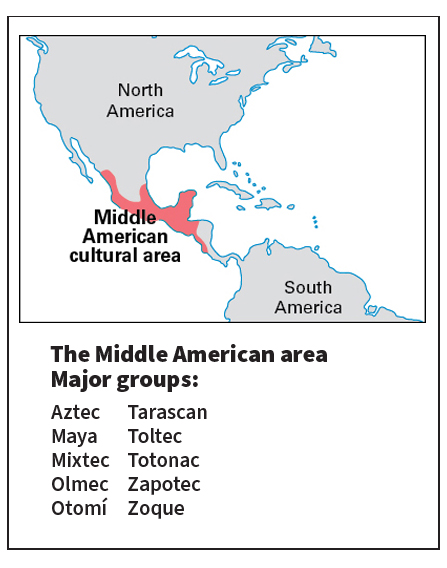
Middle American Growth of the Aztec Empire.
By the early 1400’s, Tenochtitlan had become a powerful city that controlled the region around it, forming a city-state. Tenochtitlan joined with Texcoco and Tlacopan, two other city-states in the Valley of Mexico, to form an alliance. Tenochtitlan became the most powerful member of the alliance and began to build the Aztec Empire. Under Montezuma I, who ruled from 1440 to 1469, the alliance conquered large areas to the east and south. Montezuma’s name is also spelled Moctezuma or Motecuhzoma. His successors expanded the empire until it extended between what are now Guatemala and the Mexican state of San Luis Potosí. Hundreds of conquered towns paid heavy taxes in goods to the empire. When Montezuma II became emperor in 1502, the Aztec Empire was at the height of its power.
The Spanish conquest.
In 1519, the Spanish explorer Hernán Cortés landed on the east coast of Mexico. After several skirmishes and setbacks, he began a march inland to the Aztec capital. He and his troops were eventually joined by many Indigenous people who had been conquered by the Aztec and resented their heavy taxes and brutality. For reasons that are still mysterious, Montezuma II did not oppose the advancing Spaniards with military force. Instead, he tried to use religious magic to discourage them from coming to the capital. Some scholars think he believed Cortés represented the creator god Quetzalcoatl and his Toltec incarnation Topiltzin Quetzalcoatl, who had ruled centuries before. An Aztec legend said that Quetzalcoatl had sailed away to the east, the direction from which the Spaniards came. Cortés eventually entered Tenochtitlan and made Montezuma a prisoner in his own palace.
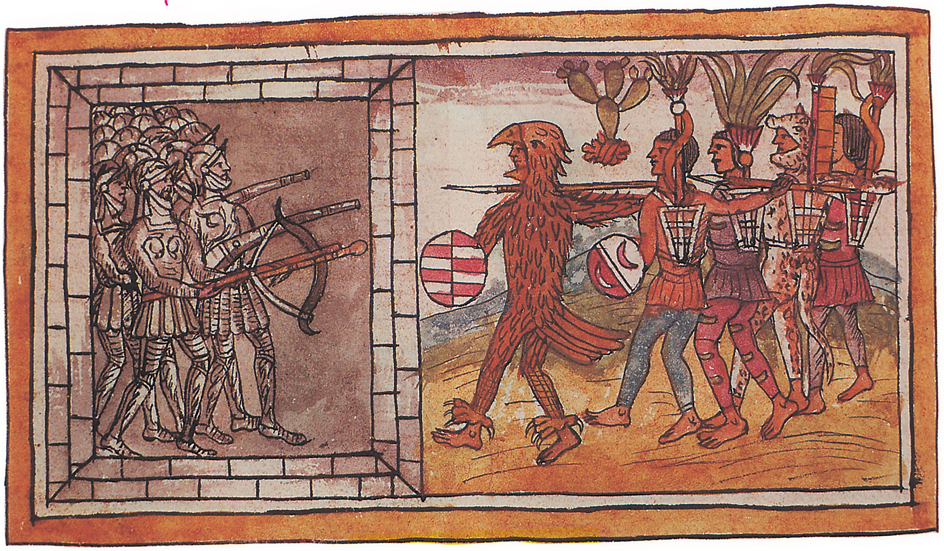
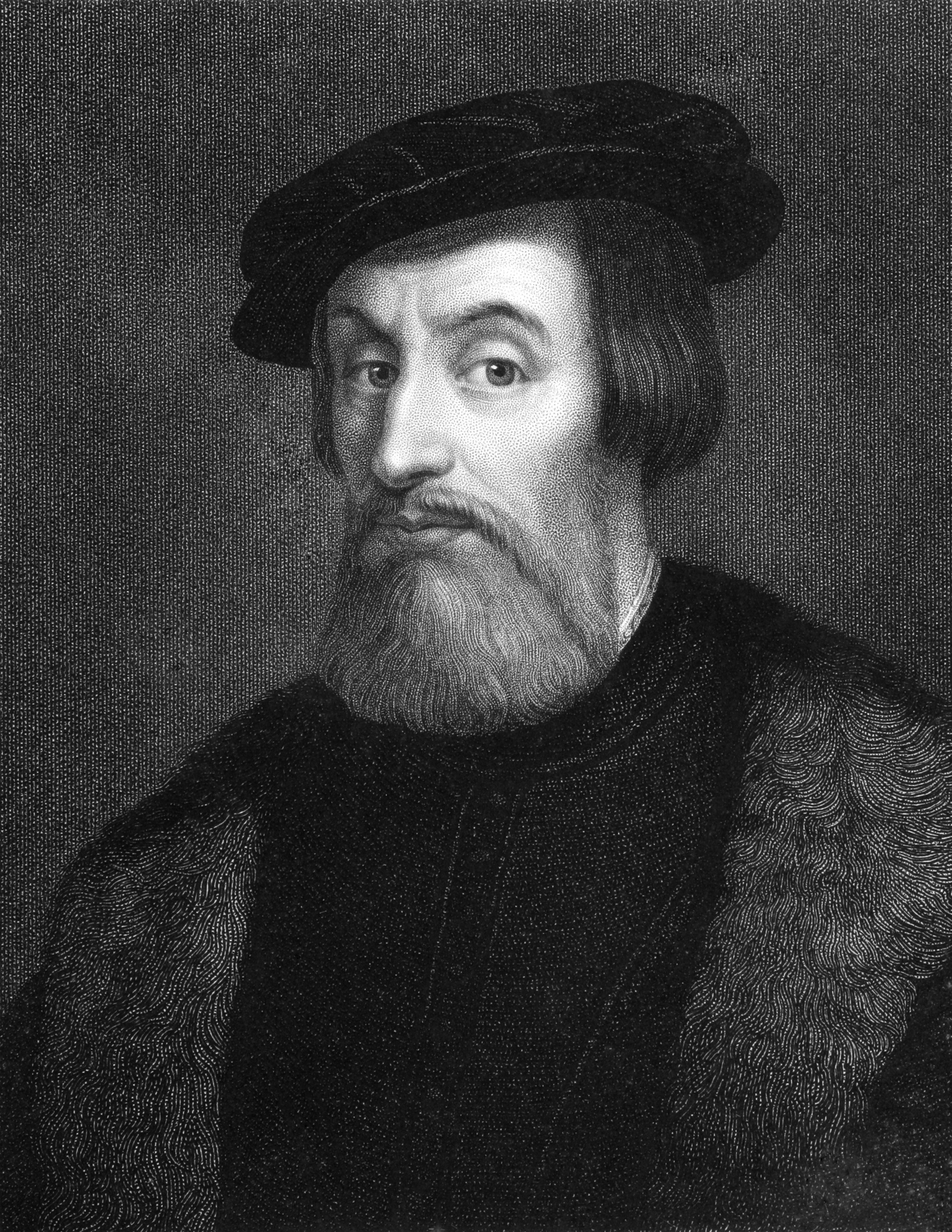
In 1520, the Spaniards massacred Aztec dancers, priests, and musicians at a sacred ceremony. The Aztec rebelled and drove the invaders from their city. Montezuma died that year, probably from wounds received early in the rebellion. Cortés and the Spaniards retreated, but soon reorganized their army and attacked Tenochtitlan in May 1521. Montezuma’s successor, Cuauhtémoc, surrendered in August of the same year.
The Aztec heritage.
Little Aztec architecture remains. The Spaniards considered it their duty as Christians to wipe out the temples, idols, sacrifices and all other traces of the Aztec religion. They destroyed Tenochtitlan and built Mexico City on the ruins. However, archaeologists have excavated the site of the Great Temple in downtown Mexico City. They have uncovered all four sides of the building and recovered thousands of objects, including jewelry, pottery, statues, wall carvings, and remains of animal and human sacrifices. Archaeologists have restored some other Aztec buildings, including temples at Tenayuca and Tepoztlan near Mexico City. The National Museum of Anthropology in Mexico City has a large collection of Aztec art.
Thousands of people in Mexico have Aztec ancestors, and many speak a modern form of Nahuatl. Many Mexican place names, including Acapulco and Mexico itself, come from Nahuatl, as do the English words avocado, chocolate, and tomato. Such Mexican painters as José Orozco, Diego Rivera, and David Siqueiros have used Aztec themes in their work. Foods of Aztec origin, including chili, chocolate, and tacos, have become popular in many countries. Descendants of the Aztec also live in the United States, especially in California and Texas. Many Mexican Americans take pride in the creative aspects of Aztec culture.
